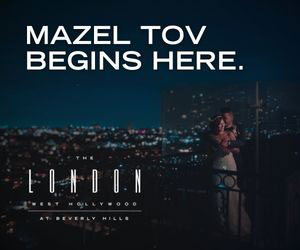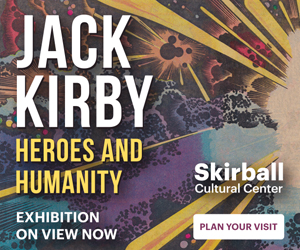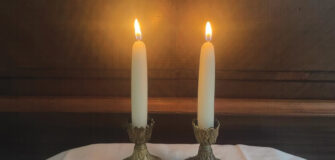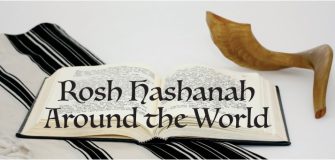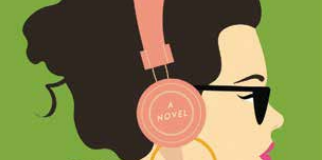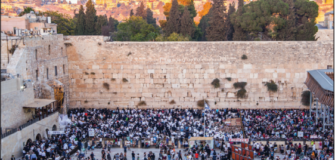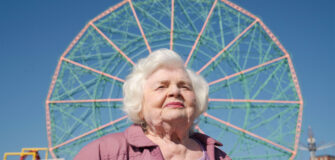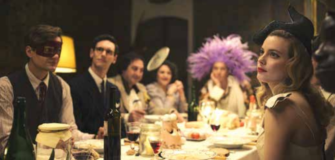The David Labkovski Project
Documenting History Through Art, Empowering Future Leaders by Teaching the Past
By Elizabeth Multer
From March 26th through April 28th, the Greater Los Angeles community has the privilege of experiencing the David Labkovski Project’s Documenting History Through Art exhibit at Hillel 818 on the CSUN campus. The exhibit, which runs over Yom Hashoah, includes two events: a conversation on March 26th with John Paul Thornton, an independent Art Historian, and Leora Raikin, David Labkovski Project Founder & Executive Director, and a presentation on April 3rd, ‘Personal Connections to the Holocaust’ with Lisa Lainer-Fagan, Connie Marco, and Keren Perlmutter, facilitated by Matt Baram, Executive Director of Hillel 818.
Hillel 818 serves a diverse Jewish community of over 6500 students on the campuses of CSUN, Pierce College, Valley College, and throughout the San Fernando Valley. “Our building is a community resource,” says Baram. “Hillel 818 is one of the best-kept secrets of the Jewish community in L.A.”
After 3 ½ years of renovations, Documenting History Through Art is Hillel 818’s first major event in the updated space. The choice was intentional: The David Labkovksi exhibition was one of the most impactful programs that 818 had ever run. It’s the “kind of project people don’t forget,” says Raikin.
Based on community response, Baram, who joined 818 in 2019, knew that the exhibit should be shown again. The first exhibition was in 2018; five years later, the current one reaches a new generation of students. Scheduling the show over Yom Hashoah is a way to speak to current generations about a receding past. “We’re living in a time when, unfortunately, there aren’t many survivors to look to,“ reflects Baram, “it’s harder for students to connect to something that feels like it was a long time ago.”

Born in 1901 in Vilna, David Labkovski painted all of his known works after emigrating to Israel in 1958. A Jewish artist, he created colorful images of life in Vilna before World War II, stark paintings of life in a Siberian camp where he was imprisoned during the war, and images of a devastated Vilna upon his return.
On their own, the paintings are significant and impart a narrative of Jewish life in pre and post-World War II in Eastern Europe and Siberia, but Documenting History Through Art is an all-encompassing experience. In addition to the art, there is an interactive VR component that allows you to enter the world of some of the paintings. There are QR codes for more in-depth information. There are self-guided brochures. Even a visit to the website offers guided tours and reflection exercises.

The exhibit is the outward-facing part of a much larger program that engages learners to document history through art. At Hillel 818, the exhibit will be docentled by CSUN students trained by the David Labkovski Project. Using Labkovski’s paintings, the DLP trains students to become docents and curators who can share their knowledge with their peers and communities. Students are encouraged to approach the artworks in a spirit of inquiry. Guided by questions like: What do you see? What do you feel? What do you want to know? What’s missing? Students are asked to note both what is present in the paintings and what things we might ordinarily take for granted are absent.
For example, in a painting of bunks in the Gulag, we see three men on three sleeping platforms, one apparently right on top of the other. There are no pillows. There are no blankets. A man has no shoes or boots. Observations like these prod a deeper understanding of the situation and expose a major theme in Labkovski’s work: man’s inhumanity to man. Raikin describes the Gulag as a “deprivation of the soul.” With no communication with the outside world permitted, prisoners felt, “forgotten, lost, and alone.”
While many 20th century artists were engaged in authentic ways of representing what they saw or translating or subverting ideas of beauty, David Labkovski took a more contemporary approach—he painted with purpose. Actively engaged in the art of reclamation, he recreated the past through the lens of the present, using his photographic memory to bring his story— and the story of his community—forward to future generations.
Raikin breaks the creative periods of his life into four sections: 500 years of Jewish life before the Holocaust, the Gulag, the post-Holocaust return to Vilna, and his time of relative bounty in Israel. “The least discussed aspect of World War II is Siberia,” Raikin says when discussing Labkovski’s wartime imprisonment. In post-war Vilna, it was forbidden to discuss either Siberia or the Holocaust.
The Vilna that Labkovski returned to was one where 99% of the Jews had been murdered during the war.
Labkovksi also painted a series based on the works of Sholom Aleichem, bringing some beloved characters to life. Through his art, Labkovski “paid respect to his whole community,” says Raikin. Her connection to Labkovski and his art are strong and personal, and her energy for this work is palpable and contagious. She is Labkovksi’s great-niece and often refers to him as uncle in conversation. Paintings of a house in Vilna—pre and post-Holocaust—is identified as her grandfather’s and the people in it, her family.

Indeed, Labkovski repeats characters in his paintings, essentially recreating his family and community on canvas. What we might now call processing trauma, Labkovski enacted through his brush strokes. Each painting evokes a moment of his life. Many of these are marked by deprivation, loss, grief, physical hardship, and isolation. Raikin points to the visceral loss present in the oft-colorful paintings. They have a way of making the loss tangible or “taking the absent and making it present… recreating it, so that it’s never forgotten.”
Exhibiting this art in Israel in 1959, Labkovski found a chilly reception. This wasn’t what people wanted to see. The works evoke a keen sense of awareness of what was left behind. Labkovksi painted these images in retrospect, already knowing the outcome of the story. The paintings are a narrative in reverse or a cautionary tale. Raiken notes that he “survived and told about two megalomaniacal totalitarian regimes.” Whether we want them or not, Labkovski has lessons for us in our own time.
The “past was always with him,” says Raikin of her uncle, “this art was his purpose.” With the David Labkovski Project, Raikin is taking the work of her uncle forward. From telling a detailed story over his lifetime of painting and over 400 canvases, to sharing that story in a way that teaches and creates leaders.
Viewing Labkovski’s work from this perspective adds empowerment to the Holocaust narrative. The DLP engages students who may have never heard of the Holocaust, encouraging them to submit art and poetry in response to the paintings. DLP’s educational programs reach learners of all backgrounds and levels. They are in their 6th year of running a program at a bilingual school in the San Fernando Valley. They have virtual programs in 40 schools and semester-long programs that allow students to keep a piece of Labkovski’s art in their room, growing a connection to the art and inviting a conversation with the artist.
As Executive Director of the DLP, Raikin’s mission is comprehensive. She wants to bring this art to other Hillels, to corporate lobbies, really, anywhere it can have an impact. It’s free and offers audiences opportunities for reflection and response. The exhibit has been designed to be accessible and portable, and it is well traveled, having been shown in spaces ranging from a riverboat cruise to Beit T’shuvah.
Raikin underscores the importance of Documenting History Through Art being the first major program in the new Hillel 818 building. For her, it is “something to counteract shortage of artistic experiences in the Valley.”
So why take the drive all the way to Northridge?
“Hopefully the event itself speaks to you, and traveling out to Northridge feels like a far off adventure—and it is worth it,” offers Baram. He points out that the students who participate in Hillel 818 programs are overwhelmingly from the Greater Los Angeles area and remain in the area after graduation. Their experiences with 818 flow directly into the larger L.A. Jewish community. “Our success in readying and stewarding them on their Jewish journey has wide-ranging ramifications.”
Creating a vibrant community is a priority at Hillel 818—and a challenge. With a large number of students on the poles of the political and religious spectrum, they work to gather students of all ethnicities, political beliefs, and religious observance. “Not every program is for every student,” says Baram. By creating events for affinity groups alongside programs for everyone, Hillel 818 builds connection and community that will ripple through future generations.
Prods Baram, “Come for the art, and learn about 818.”
The David Labkovksi Project: Documenting History
Through Art, March 26th – April 28th, 2023,
Presented by Hillel 818 @CSUN, 17729 Plummer Street,
Northridge, CA 91425
www. Davidlabkovskiproject.org






